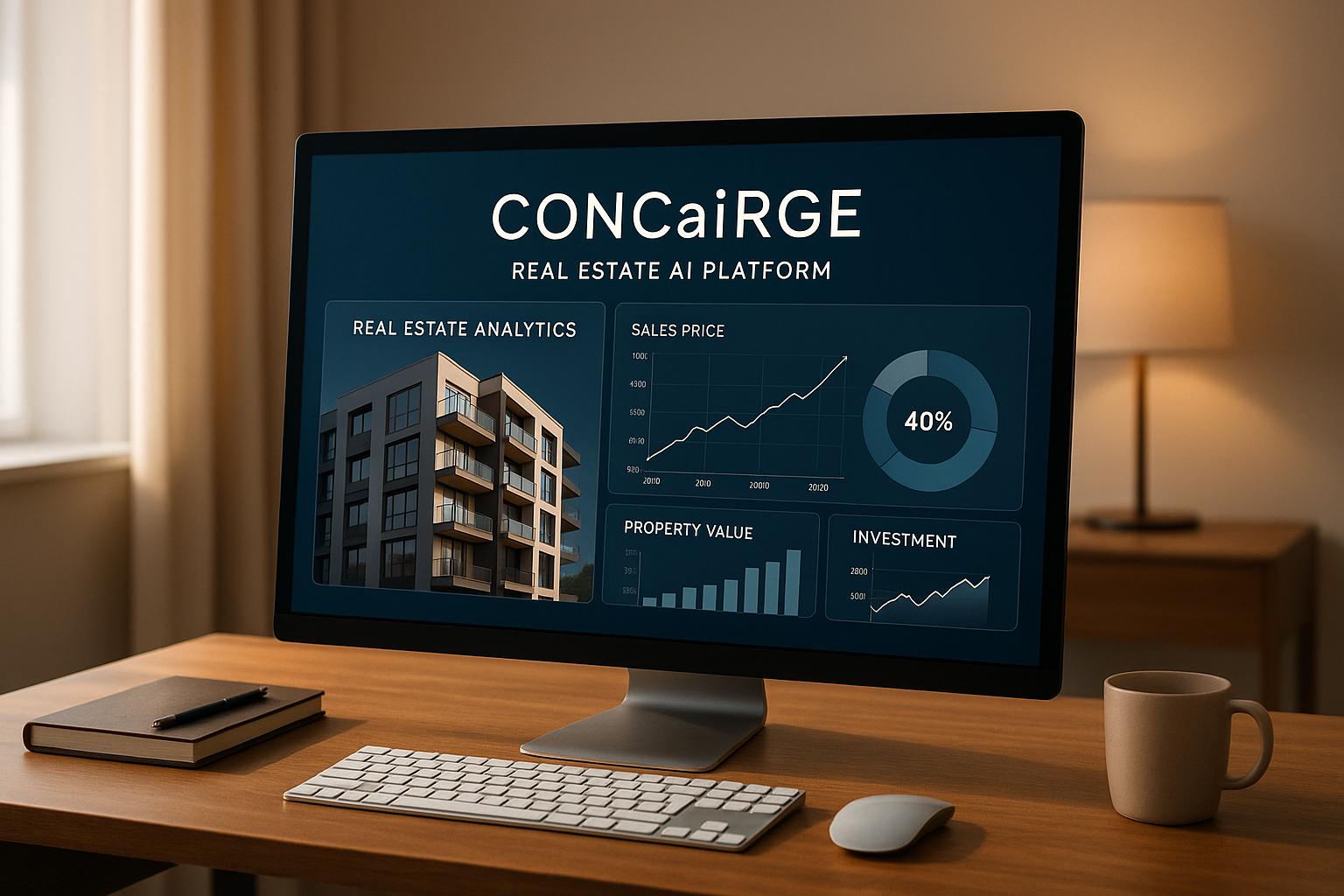Predictive analytics transforms real estate CRM systems by helping agents predict client behavior, prioritize leads, and analyze market trends. Here's how it works and why it matters:
- Lead Scoring: Rank leads based on data like engagement, financial readiness, and property preferences.
- Market Insights: Use historical and current data to refine property pricing and spot trends.
- Personalized Service: Tailor communication and property suggestions based on client behavior.
- Automation: Schedule follow-ups, send alerts, and optimize outreach timing automatically.
Predictive Analytics Basics for Real Estate CRM
Data Sources and Pattern Analysis
Real estate CRMs pull from a variety of data sources to create actionable insights:
- Property Data: MLS listings, historical sales figures, and property features.
- Client Interactions: Email engagement, website activity, and requests for property showings.
- Market Data: Neighborhood trends, economic indicators, and local development updates.
- Public Records: Tax assessments, ownership details, and building permits.
By analyzing this data, CRMs can identify patterns that reveal client preferences. Advanced algorithms transform raw information into insights that directly support lead scoring and automation processes.
Lead Scoring Systems
Modern CRMs use predictive analytics to rank leads based on specific criteria. Here's how a typical scoring system works:
| Factor | Weight | Indicators |
|---|---|---|
| Engagement Level | High | Email replies, property inquiries |
| Financial Readiness | High | Mortgage pre-approval, price range searches |
| Timeline Signals | Medium | Frequency of searches, showing requests |
| Property Match | Medium | Saved listings, viewing history |
These scores are dynamic, adjusting as new data becomes available. For example, if a lead starts exploring higher-priced homes, their score might increase, signaling a stronger likelihood of conversion. This scoring feeds directly into automated marketing strategies.
Marketing Automation
Predictive analytics powers marketing automation by tailoring outreach to customer behavior. CRMs can:
- Trigger automated actions: For example, sending market updates or new property alerts when a lead shows interest in a specific area.
- Personalize content: Highlight properties that align with a client’s preferences, like specific amenities or locations.
- Optimize timing: Use past interaction data to schedule outreach when leads are most likely to respond.
Studies show that predictive analytics significantly boosts lead conversion rates when integrated into CRM systems. To get the most out of these tools, agents should look for platforms offering real-time data updates, customizable scoring, automated workflows, and strong data security. These features help agents turn insights into practical strategies, improving efficiency and results.
Main Advantages for Real Estate Agents
Better Lead Quality and Conversion
Predictive analytics helps real estate agents zero in on top-quality leads by analyzing past transactions, client behavior, and market trends. This means agents can:
- Prioritize leads that are more likely to engage
- Time their follow-ups to connect when prospects are most likely to respond
- Tailor their outreach based on predicted preferences and actions
With this approach, agents can focus on high-value interactions, making follow-ups more effective and pricing strategies more precise.
Accurate Price and Market Analysis
Predictive analytics processes large amounts of market data to fine-tune property valuations. By considering historical sales, property details, current market trends, and broader economic factors, it provides highly accurate pricing and valuation insights.
Improved Client Service
Predictive analytics also helps agents offer a more personalized experience to their clients. Using data-driven insights, agents can:
- Highlight property features that align with a client’s browsing habits
- Schedule showings at times that fit a client’s availability
- Recommend properties based on past interactions and preferences
Setting Up Predictive Analytics in CRM
CRM System Assessment
To ensure accurate predictions, keep 12–18 months of clean, well-maintained data in your CRM. Pay attention to:
- Data completeness and organization: Your CRM should hold detailed client information, transaction histories, and property records in a structured format.
- System compatibility: Make sure your CRM integrates smoothly with modern predictive analytics tools.
Data Source Connection
After confirming your CRM's readiness, enrich it with key data sources:
- MLS Integration: Link your CRM to your local Multiple Listing Service for up-to-date property data.
- Public Records: Connect to county assessor databases to access property ownership and history details.
- Market Analytics: Add neighborhood statistics and market trend information for deeper insights.
- Digital Interaction Data: Track metrics like website visits, email engagement, and client interactions.
Set up daily automated data synchronization to keep your CRM accurate and up-to-date.
Tool Selection and Setup
Choose predictive tools that align with your goals:
1. Integration Requirements
Pick tools that connect seamlessly to your CRM using direct API integrations and automated workflows.
2. Core Features
Look for tools offering these predictive functions:
- Lead scoring to prioritize prospects
- Property valuation models for pricing insights
- Client behavior analysis to understand engagement patterns
- Forecasting tools for market trends
3. Implementation Steps
Begin by testing one predictive feature to ensure accuracy. Gradually add more features and train your team on their use.
Perform quarterly audits to confirm the reliability of your predictions and make adjustments as needed.
sbb-itb-db182b0
Using Predictive Analytics Effectively
Combining AI with Human Expertise
Use AI tools for tasks like market analysis, lead scoring, and automated follow-ups, but always pair them with local knowledge. For instance, if Dialzara suggests a listing price based on market data, cross-check it with your understanding of neighborhood trends, property features, and buyer preferences. This combination ensures recommendations are practical and aligned with real-world conditions. Regularly reviewing these insights helps maintain their relevance over time.
Keeping Systems Current
To maintain accuracy, update your predictive system regularly. Evaluate data quality, monitor how well the model performs, and tweak prediction settings to reflect changes in the market. Document these updates to measure their influence on your decisions and ensure continuous improvement.
Unlocking Real Estate Success with Predictive Analytics
Conclusion
Predictive analytics is reshaping how real estate professionals use CRMs, combining data-driven insights with the irreplaceable value of human expertise. Pricing starts at $29 per month for individual agents and goes up to around $260 monthly for teams of up to 10, making it accessible for businesses of various sizes.
- Evaluate Your CRM: Ensure it integrates well with predictive analytics tools.
- Streamline Data Sources: Connect reliable and diverse data sources for better accuracy.
- Prioritize Security: Strengthen data protection to safeguard sensitive information.
By taking these steps, you can make the most of predictive analytics in your CRM. Regular updates, accuracy checks, and fine-tuning parameters will help strike the right balance between automation and professional judgment.
For more tools and resources tailored to real estate professionals, check out AI Tools For Real Estate Agents.
FAQs
How can predictive analytics improve lead scoring in real estate CRM systems?
Predictive analytics enhances lead scoring in real estate CRM systems by using data-driven insights to identify and prioritize high-potential leads. By analyzing historical data, market trends, and customer behaviors, predictive models can assign scores to leads based on their likelihood to convert. This helps agents focus their efforts on the most promising opportunities, saving time and boosting efficiency.
Additionally, predictive analytics can provide personalized recommendations for engaging with leads, such as suggesting the best time to follow up or highlighting key factors that influence their decision-making. This level of precision allows real estate professionals to build stronger relationships and close deals more effectively.
What types of data should real estate agents include in their CRM to make the most of predictive analytics?
To maximize the benefits of predictive analytics in a real estate CRM, agents should integrate key data sources that provide actionable insights. These include:
- Client information: Demographics, preferences, and past interactions to identify potential leads and tailor communication.
- Market trends: Local property values, neighborhood statistics, and seasonal patterns to predict demand and pricing.
- Transaction history: Records of previous sales, listings, and client activities to forecast future opportunities.
By combining these data points, predictive analytics can help agents anticipate client needs, optimize marketing efforts, and improve overall efficiency in their operations.
How can real estate agents keep their predictive analytics tools accurate and effective over time?
To maintain the accuracy and effectiveness of predictive analytics tools, real estate agents should regularly update their data inputs. Using the most current and relevant data - such as market trends, client preferences, and property values - ensures predictions stay aligned with real-world conditions.
Additionally, periodic reviews and adjustments to the algorithms or models powering these tools are essential. This can involve collaborating with data specialists or using AI tools specifically designed for real estate to refine predictions and adapt to evolving market dynamics. Regular monitoring and fine-tuning will help ensure these tools remain a valuable asset in your CRM strategy.


